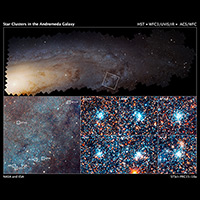All stars are not created equal. They can vary in mass by over a factor of 1,000. Our sun is classified as a diminutive yellow dwarf. What's more, stars are not born in isolation, but inside giant molecular clouds of hydrogen. The question has been: what fraction of stars precipitate out of these clouds into clusters that contain blue giants, yellow dwarfs, and red dwarfs?

It's like asking if all automobile manufacturers fabricate the same proportion of trucks, SUVs, sedans, and subcompacts. The best way to address the question is not to look around our Milky Way — which we are inside — but far out into space to the neighboring Andromeda galaxy, 2.5 million light-years away. Embedded in a sweeping Hubble Space Telescope mosaic of 117 million stars in the galaxy's disk are 2,753 star clusters. Hubble astronomers found that, for whatever reason, nature apparently cooks up stars like batches of cookies. There is a consistent distribution from massive stars to small stars. It is surprising to find that this ratio is the same across our neighboring galaxy (as well as inside our stellar neighborhood in the Milky Way), given the complex physics of star formation.
For more information about this study,visit the story at
http://hubblesite.org/newscenter/archive/releases/2015/18/full/
